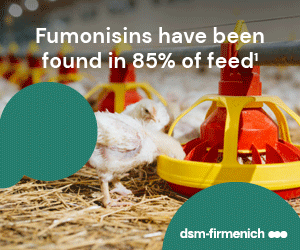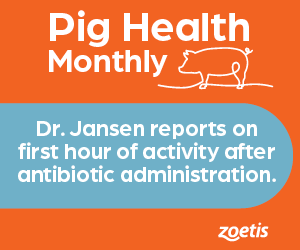



Influenza A virus remains costly challenge for US pork industry
Influenza A virus in swine (IAV-S) continues to challenge the US pork industry. While its mortality rate is low, it causes acute respiratory disease and, according to the Iowa State University Center for Food Security and Public Health, often leads to reduced growth rates in young pigs, which can cause economic losses.1
Typical signs include fever, depression, coughing (barking), discharge from the nose or eyes, sneezing, breathing difficulties, eye redness or inflammation, and going off feed.2 However, some pigs infected with influenza may show no signs of illness at all.3
Costly virus
Because morbidity is more common than mortality, it’s difficult to put a dollar figure on the cost of IAV-S in a herd, but with tight margins, any loss is costly.
Outbreaks can also disrupt markets. In 2009, for example, H1N1 was discovered in a 5-year-old boy who lived near a pig farm in Mexico. The virus was labeled “swine flu,” and US pork sales plummeted.4 The US felt the hit in the weeks following the first outbreak, when 27 nations blocked all US pork imports. Domestic demand plunged as well. From April to October 2009, the US industry lost an estimated $1.1 billion, largely attributed to concern surrounding H1N1.5
Between the diversity of the virus and its ability to move between species, it’s important for veterinarians and producers to know which flu viruses are circulating in order to plan effective control programs.
Marie Culhane, DVM, PhD, has worked with influenza in numerous species and understands the virus well. In her work with swine and turkeys, the associate professor at the University of Minnesota’s College of Veterinary Medicine has researched the antigenic and genetic characterization of IAV, as well as the pathogenesis of unique IAV infections. She’s also looked at the possible impact these viruses may have on current vaccination protocols in the US livestock industry.
Like many diseases, influenza has been around for centuries. During the 1918 flu pandemic, which is estimated to have afflicted one-fifth of the earth’s population at the time, it killed an astounding 50 million people, according to the National Archives.6
Using advanced techniques, Culhane said, scientists have determined that the 1918 virus was an H1N1 subtype from birds that got into humans and swine at the same time.7 That H1N1 virus evolved in swine and was stable for about 70 years. Toward the end of the 20th century, a new subtype of the influenza virus, H3N2, was transmitted from humans to swine….
| References | ||||
|---|---|---|---|---|
| 1 Swine Influenza. The Center for Food Security and Public Health. http://www.cfsph.iastate.edu/Factsheets/pdfs/swine_influenza.pdf | ||||
| 2 Ibid. | ||||
| 3 Ibid. | ||||
| 4 Pork Industry Still Reeling from Swine Flu, ABC News, 2009 Oct. 16. https://abcnews.go.com/Business/pork-industry-reeling-swine-flu/story?id=8840004 | ||||
| 5 Ibid. | ||||
| 6 The Influenza Epidemic of 1918. https://www.archives.gov/exhibits/influenza-epidemic/ | ||||
| 7 Anhlan D, Grundmann N, Makalowski W, Ludwig S, Scholtissek C. Origin of the 1918 pandemic H1N1 influenza A virus as studied by codon usage patterns and phylogenetic analysis. RNA. 2011;17(1):64-73. doi:10.1261/rna.2395211. | ||||
















